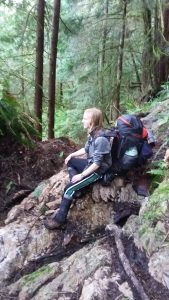Often a story is composed of many words. Sometimes a single word contains a multitude of stories. Looking back on the “Words of Welcome” with which I launched this blog, I can see that “welcome” is itself a word of many stories: narratives of travel, customs of hospitality, stories of home. A speech act theorist might say it has a definite illocutionary force, calling into being a network of material and affective relationships. Or you might say that “welcome” is a word of magic, one that alters the world.
In If This Is Your Land, Where Are Your Stories?, J. Edward Chamberlin reflects on the intersections and contradictions between word and world. This relationship, like that between reality and the imagination (and any number of binary pairs), is not one of antagonistic exclusion. On the contrary, Chamberlin’s “world of words” brings us closer to “the world we live in,” providing imaginative structures with which to articulate our relationships and experiences with and within that world (1). Although considered to a certain degree arbitrary, words are no less real, no less “true” than our everyday material reality. Indeed, Chamberlin would suggest, that very reality is the creative product of discourse, of stories.
Our investment in words—recognized as both meaningless and meaningful—exemplifies the ceremonies of belief, surprise, and wonder that Chamberlin considers central to the project of finding common ground between Us and Them. Chamberlin puts forward two ancient and magical examples of “the perversity and the power of language” (175): riddles and charms. In riddles, the grammars, logics, sounds and rhythms of language perform the acrobatics of meaning-making—the topography of language does a back bend to lend the topography of the world a new wonder and coherence. In charms, on the other hand, “the world gives” (180): dreams, imaginings, and songs shape the world, give us comfort in the midst of sorrow (even by means of it), grip us with a sense of broader community.
Recently, cognitive linguistics has allowed us to picture how language does not simply serve as a vehicle of communication but fundamentally underlies our most intimate experiences of thought and feeling. Metaphor—that tricky “hinge” of language’s strangeness (Chamberlin 162)—may be no mere poetic device but a crucial conceptual tool, one that allows us to imagine the immaterial but nonetheless real (love, value, sovereignty, progress, anger, understanding) in terms of the concrete and embodied (heat, movement, light, objects). (Here is a lecture from our very own UBC on the fascinating research being done in conceptual metaphor theory and embodiment.) What came first, the thought or the metaphor? The world or the story?
Where do we go when we enter the world of words? Everywhere and nowhere, Chamberlin might reply with his penchant for paradox. But words can also bring us to the most specific, localized, and intense contact with the world. Robert Macfarlane, for instance, has shown in the course of several books how language can be a technology of love and wonder. His 2015 book Landmarks (“a book about the power of language . . . to shape our sense of place”) collects hundreds of unique dialect words whose specificity bespeaks old and intimate knowledge of particular places, regions, and climates (1). And his books of poetry—The Lost Words (2017) and The Lost Spells (2020)—invoke words (like acorn and conker) that run the risk of disappearing if the contact with the non-human world that they both require and render possible ceases to be a part of our lives. (This is a “charming” video about The Lost Spells that suggests the entanglement of art/word/imagination and reality/world.)
I first came across The Lost Words when I was slightly lost myself. I was studying abroad in Edinburgh and had taken a long walk out of the city centre to the Royal Botanic Garden. Among the flowers was a white gallery house with The Lost Words exhibition inside: a series of paintings and acrostic verses lamenting the absences and conjuring the presences of both specific words and living things. I came home with the book, and I now feel that these verses are fine examples of the Chamberlinian charm, the potent overlapping of word and world.
Works Cited
Chamberlin, J. Edward. If This is Your Land, Where are Your Stories? Finding Common Ground. Knopf, 2003.
Gibbs, Raymond. “Raymond Gibbs — Second of a Double Feature: Metaphor and Embodied Cognition.” The University of British Columbia, 25 October 2010, https://ikblc.ubc.ca/raymond-gibbs-second-of-a-double-feature-metaphor-and-embodied-cognition/.
Macfarlane, Robert. Landmarks. Penguin, 2015.
Macfarlane, Robert, and Jackie Morris. The Lost Spells. Penguin, 2020.
—. The Lost Words. Penguin, 2017.
“The Lost Spells by Robert Macfarlane and Jackie Morris.” Youtube, uploaded by Waterstones, 5 October 2020, https://youtu.be/n_oma3YP5NU.
